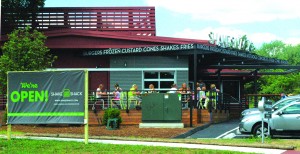Fickle fandom with fries

The excitement that surrounds the newest county arrival in destination retail, Shake Shack, could be short lived, experts say, unless the business is shrewd about its new suburban marketplace.
The fixation inspiring Manhattan-based burger chain has recently brought its burger, dogs, fries and malteds to Post Road in Westport.
David Firestein, president of Northwest Atlantic Real Estate Services in White Plains, N.Y., which has a long reputation in placing destination food retailers, said that Shake Shack is one of the stories of the hour with an amazing following known throughout the industry.
“It will be interesting to see how they approach moving into the suburban space,” Firestein said. “Operating in the suburban market is not the same as having a store in Times Square; there the store is open 24/7 ”“ you can have a great business going at midnight on a Wednesday. That won”™t be the case ion Westport.”
Opening its first location in Manhattan in 2004, Shake Shack currently has 14 locations including restaurants in Saratoga Springs, Washington, D.C., Miami, Dubai in the United Arab Emirates and Kuwait City, Kuwait. Westport is the burger purveyor”™s first location that is not in an urban center.
“We wanted to learn whether Shake Shack would play in a non-urban community,” said restaurateur Danny Meyer, whose company, Union Square Hospitality Group, owns Shack Shake. Meyer said they chose Westport as the first suburban test market because of its proximity to New York enabling the group to keep a close watch over it while allowing it to have its own market share.
Firestein said destination food chains succeeding in new markets can be hard to forecast.
“Only a few years ago Krispy Kreme was the big destination draw,” Firestein said. “With the one that opened in Newtown you had traffic making the news it was so backed up. Now that same store is closed. For destination locations things can very easily go from one extreme to the other over a relatively short amount of time.”
At the eve of its opening, more than 150 guests gathered at the restaurant to sample Shake Shack favorites, and the next day droves of people walked up Post Road, overflowing the parking lot into the retail mall”™s lot across the street.
Firestein said parking is another issue that urban food chains often overlook when moving out of the urban space.
“From what I”™ve seen of where Shake Shack was placed on the Post Road, they”™ve underestimated the parking and that is going to be a major issue,” he said. If Shake Shack maintains a consistent flow of business, he said, the parking limitations could become a real problem and even drive away customers.
“You can”™t expect people to be running across a double-lane road, or other landlords standing for Shake Shack customers using their lots,” Firestein said. “You have to learn to adjust.”
The Shake Shack location can seat 100 customers with 20 of that in an outdoor area.
Firestein said it is relatively easy to achieve approval for a location in urban centers such as Manhattan. But, suburban locations have the most tie-ups.
“In suburban markets you have neighbors, parking, convenience and flow of foot and car traffic all factoring into the equation,” he said.
The Shake Shack model is named after its order process in which you place your order and walk away, waiting for a small tablet to shake, telling you your order”™s ready. The price is also a draw, a single hamburger, regardless of topping, is under $4. The menu also includes a variety of drinks, including wine and Brooklyn Brewery beer.
“I want this to be a beloved member of the community and appeal to people from all different walks of life,” Meyer said. He hopes the new location will not just be an eatery, but a place to meet and socialize.
Firestein said businesses like Shake Shack need to be able to perform on service. Delivering a consistent product, no matter how well tuned, can be an issue for suburban retailers because of the difficulty in staffing, he said.
“In the city you can staff up fairly easily with public transit, but in Westport you have to spend money on gas, It”™s a question of where are your employees going to come from?”
The Westport location has 60 employees.
Firestein said that even paradigms of destination-style retailing like Starbucks and Apple, face the challenges of losing their destination allure.
“When Apple opened in Greenwich that was a great draw, but now they”™re opening in Westport and Grand Central, each of those stores will compete with one another and work to make it less of a destination,” Firestein said. Shake Shack will also be opening a Grand Central Terminal location later this year.
Firestein said a business such as REI, which recently opened in Norwalk and at the Ridge Hill development in Yonkers, N.Y., is a good example of a business that still has a strong destination appeal.
“Although they”™re adding more of them, there are still not that many, and there”™s not much that compares to it,” he said.
A paralleled arrival of similar business models can also detract from the destination appeal of a store. Shake Shack has immediate competitors in the businesses like Elevation Burger and Five Guys Burgers, which are both expanding in the New York metro area market.
Firestein said food businesses do have the ability to create destination appeal more than most other types of retail.
“Most other things are easier to duplicate. But over time everything becomes less of a destination.”